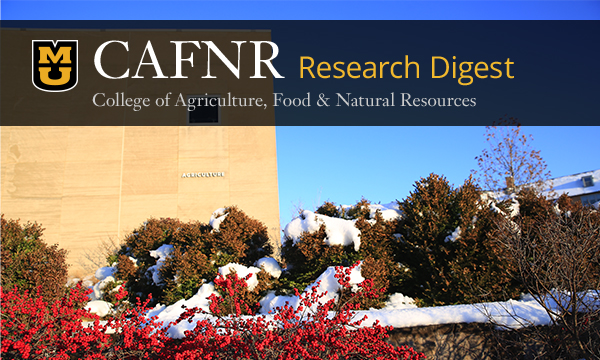|
Guyette honored with lifetime achievement award
Rich Guyette, research professor emeritus, School of Natural Resources, has received the Herbert Stoddard Lifetime Achievement Award from the Association for Fire Ecology (AFE). The 2019 Lifetime Achievement awardees have demonstrated a career’s worth of meaningful contributions to expanding our understanding and application of fire ecology, and have inspired and mentored a generation of fire scientists and managers, according to AFE. From his first peer-reviewed fire-scar history article published in 1982, Guyette is one of the most published and cited scientists of fire ecology literature in the eastern U.S. Across the eastern U.S. in particular, his research has been instrumental in justifying the need for fire management including landscape-scale restoration projects on federal and state lands, according to AFE.
Li receives Connecting with Missouri Grant
Christine Li, assistant professor in the School of Natural Resources, was recently named one of the first recipients of the Connecting With Missouri grant from the Connector, a UM system resource. She specializes in environmental education research and teaching; her project is titled, “Climate Youth Engagement: Enhancing Climate Literacy and Community Resilience through Science-Based Deliberative Forums and Actions.”
Plant Sciences grad students win awards at recent meeting
The North Central Weed Science Society of America honored three Plant Sciences graduate students with awards in the Graduate Paper Contest during the recent annual meeting in Columbus, Ohio.
- Will Tubbs, master’s student, received first place in the Agronomic Crops Section
- Eric Oseland, doctoral student, placed second in the Agronomic Crops Section
- Jerri Lynn Henry, doctoral student, earned second place in the Equipment and Application Methods Section.
CAFNR faculty members have received the following recent grants (listed by Principal Investigator):
Kevin W. Bradley, Integrating Best Management Practices for Weeds with Multiple Herbicide Resistance in Soybean Production Systems (FY20), 10/1/2019-9/30/2020, $115,000, Agricultural Research Service
Pengyin Chen, Towards the Development of High-Yielding Cultivars & Germplasm with Optimum Oil and Protein Content and Innovative Oil Attributes for the Current Market, 10/1/2019-9/30/2020, $66,816, Ohio State University
Pengyin Chen, Discovery and deployment of novel genes for durable resistance to multiple nematode population in soybean, 10/1/2019-9/30/2020, $55,843, University of Georgia
Daniel Downing, Heartland Extension Disaster Education Network Building Resiliency in the Heartland, 9/1/2019-8/31/2021, $97,937, National Institute of Food and Agriculture
Felix Fritschi, Utilizing Genes from the Soybean Germplasm Collection to Mitigate Drought Stress, 10/1/2019-9/30/2020, $180,192, University of Arkansas
James Heiser, Successfully Deploying Post-Emergence + Overlapping Residual: Calendar vs. Weed Height?, 1/1/2020-12/31/2020, $10,750, Cotton Inc.
Dae-Young Kim, Enhancing the Economic Sustainability of Missouri Agritourism, 12/2/2019-1/29/2021, $155,000, Missouri Agriculture and Small Business Development Authority
Mengshi Lin, Effect of Nanocellulose and Food Matrix on Mucosal Structure, Nutrient Absorption and Colonic Fermentation, 9/1/2019-8/31/2022, $84,323, University of Georgia
Kevin Rice, Soybean Gall Midge: Surveying the North Central Region, Adult Monitoring and Host Plant Resistance, 10/1/2019-8/31/2020, $10,000, University of Nebraska-Lincoln
Andrew M. Scaboo, Discovery and deployment of novel genes for durable resistance to multiple nematode population in soybean, 10/1/2019-9/30/2020, $39,997, University of Georgia
Andrew M. Scaboo, Increasing Genetic Diversity, Yield, and Protein of US Commercial Soybean Germplasm, 10/1/2019-8/31/2021, $73,890, University of Nebraska-Lincoln
William Stevens, Cotton Nitrogen Management with Urea and Controlled Release Fertilizer Mixtures on Silt Loam Soils, 1/1/2020-12/31/2020, $11,200, Cotton Inc.
Henry Nguyen, Modifying Soluble Carbohydrates in Soybean Seed for Enhanced Nutritional Energy Meal, 10/1/2019-9/30/2020, $294,758, Purdue University
William Wiebold, Improving on Perfection: Gene Editing to Reduce or Eliminate Anti-Nutritional Factors in Soybean Seeds that have been Shown to Reduce Economic Value, 10/1/2019-9/30/2020, $139,380, Purdue University
Jeffrey Wood, Missouri Ozark AmeriFlux (MOFLUX) Project Phase Four, 10/3/2016-9/30/2021, $48,000, Oak Ridge National Lab
Provided by the MU Office of Research
|
